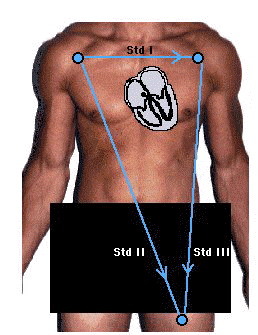-
1Primary Reference:
Garcia, T.B and Holtz, N.E.: 12_Lead ECG: The Art of
Interpretation. Jones and Bartlett Publishers, Sudbury,
Massachusetts, 2001
-
2Primary Reference:
Harrison's online (Chapter 31, Part 1
Josephson, Zimetbaum, Buxton, Marchlinski)
-
3Primary Reference:
Harrison's online (Chapter 39, Part 2 Myerburg, Castellanos)
-
Reference: Guyton, AC, "Heart Muscle; The Heart as a Pump, Chapter
9, in Textbook of Medical Physiology 9th Edition, W. B. Saunders
Company, Philadelphia, pp. 107-119, 1996.
-
Primary Reference:
Ross, AF, Gomez, MN. and Tinker, JH Anesthesia for Adult Cardiac
Procedures in Principles and
Practice of Anesthesiology (Longnecker, D.E., Tinker, J.H. Morgan,
Jr., G. E., eds) Mosby, St. Louis, Mo., pp. 1659-1698, 1998.
-
Reference Blanck, Thomas J.J. and Lee, David L, Cardiac Physiology, in Anesthesia, 5th edition,vol
1, (Miller, R.D, editor;
consulting editors, Cucchiara, RF, Miller, Jr.,ED, Reves, JG,
Roizen, MF and Savarese, JJ) Churchill Livingston, a Division of
Harcourt Brace & Company, Philadelphia, pp. 619-646, 2000.
-
Primary Reference:
Berne, R.M and Levy, M. N. Cardiovascular Physiology,8th Edition,
Mosby, St. Louis, Mo. 2001
-
Reference:
Crawford, M. H. and DiMarco, J. P, Cardiology, Mosby, St. Louis,
MO. 2001
-
Shanewise, JS and Hug, Jr., CC, Anesthesia for Adult Cardiac
Surgery, in Anesthesia, 5th edition,vol 2, (Miller, R.D, editor;
consulting editors, Cucchiara, RF, Miller, Jr.,ED, Reves, JG,
Roizen, MF and Savarese, JJ) Churchill Livingston, a Division of
Harcourt Brace & Company, Philadelphia, pp. 1753-1799, 2000.
-
Reference: Wray Roth, DL, Rothstein, P and Thomas, SJ Anesthesia for Cardiac
Surgery, in Clinical Anesthesia, third edition (Barash, PG,
Cullen, BF, Stoelting, R.K, eds), Lippincott-Raven Publishers,
Philadelphia, pp. 835-865, 1997
|
